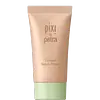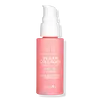What's inside
What's inside
 Key Ingredients
Key Ingredients

 Benefits
Benefits

 Concerns
Concerns

 Ingredients Side-by-side
Ingredients Side-by-side

Water
Skin ConditioningCetyl Ethylhexanoate
EmollientGlycerin
HumectantEthylhexyl Methoxycinnamate
UV AbsorberSynthetic Fluorphlogopite
Mica
Cosmetic ColorantCetearyl Alcohol
EmollientGlyceryl Stearate
EmollientPEG-100 Stearate
Sorbitan Stearate
EmulsifyingSorbitan Sesquioleate
EmulsifyingPhenoxyethanol
PreservativeAmmonium Acryloyldimethyltaurate/Vp Copolymer
Panthenol
Skin ConditioningHydroxyethyl Acrylate/Sodium Acryloyldimethyl Taurate Copolymer
Emulsion StabilisingHydrogenated Polydecene
EmollientDisodium EDTA
Polysorbate 80
EmulsifyingTin Oxide
AbrasiveTocopheryl Acetate
AntioxidantAscorbic Acid
Antioxidant1,2-Hexanediol
Skin ConditioningRetinyl Palmitate
Skin ConditioningSodium Hyaluronate
HumectantTocopherol
AntioxidantTitanium Dioxide
Cosmetic ColorantIron Oxides
Water, Cetyl Ethylhexanoate, Glycerin, Ethylhexyl Methoxycinnamate, Synthetic Fluorphlogopite, Mica, Cetearyl Alcohol, Glyceryl Stearate, PEG-100 Stearate, Sorbitan Stearate, Sorbitan Sesquioleate, Phenoxyethanol, Ammonium Acryloyldimethyltaurate/Vp Copolymer, Panthenol, Hydroxyethyl Acrylate/Sodium Acryloyldimethyl Taurate Copolymer, Hydrogenated Polydecene, Disodium EDTA, Polysorbate 80, Tin Oxide, Tocopheryl Acetate, Ascorbic Acid, 1,2-Hexanediol, Retinyl Palmitate, Sodium Hyaluronate, Tocopherol, Titanium Dioxide, Iron Oxides
Water
Skin ConditioningEthylhexyl Olivate
Skin ConditioningStearyl Alcohol
EmollientCetyl Alcohol
EmollientHelianthus Annuus Seed Oil
EmollientCaprylic/Capric Triglyceride
MaskingCoco-Caprylate
EmollientGlyceryl Stearate
EmollientEthyl Macadamiate
Skin ConditioningSr-Hydrozoan Polypeptide-1
HumectantSodium Hyaluronate
HumectantCaffeine
Skin ConditioningCitrus Aurantium Dulcis Flower Extract
Skin ConditioningAstrocaryum Tucuma Seed Butter
EmollientCarthamus Tinctorius Seed Oil
MaskingJasminum Officinale Extract
MaskingTocopherol
AntioxidantSqualane
EmollientPropanediol
SolventCaprylhydroxamic Acid
Caprylyl Glycol
EmollientLauroyl Lysine
Skin ConditioningOctyldodecyl Oleate
EmollientButyrospermum Parkii Butter
Skin ConditioningMica
Cosmetic ColorantTin Oxide
AbrasiveGlycerin
HumectantXanthan Gum
EmulsifyingStearyl Phosphate
EmulsifyingSodium Gluconate
Skin ConditioningCitric Acid
BufferingSodium Hydroxide
BufferingSodium Benzoate
MaskingParfum
MaskingCI 77891
Cosmetic ColorantCI 77491
Cosmetic ColorantWater, Ethylhexyl Olivate, Stearyl Alcohol, Cetyl Alcohol, Helianthus Annuus Seed Oil, Caprylic/Capric Triglyceride, Coco-Caprylate, Glyceryl Stearate, Ethyl Macadamiate, Sr-Hydrozoan Polypeptide-1, Sodium Hyaluronate, Caffeine, Citrus Aurantium Dulcis Flower Extract, Astrocaryum Tucuma Seed Butter, Carthamus Tinctorius Seed Oil, Jasminum Officinale Extract, Tocopherol, Squalane, Propanediol, Caprylhydroxamic Acid, Caprylyl Glycol, Lauroyl Lysine, Octyldodecyl Oleate, Butyrospermum Parkii Butter, Mica, Tin Oxide, Glycerin, Xanthan Gum, Stearyl Phosphate, Sodium Gluconate, Citric Acid, Sodium Hydroxide, Sodium Benzoate, Parfum, CI 77891, CI 77491
 Reviews
Reviews

Ingredients Explained
These ingredients are found in both products.
Ingredients higher up in an ingredient list are typically present in a larger amount.
Glycerin is already naturally found in your skin. It helps moisturize and protect your skin.
A study from 2016 found glycerin to be more effective as a humectant than AHAs and hyaluronic acid.
As a humectant, it helps the skin stay hydrated by pulling moisture to your skin. The low molecular weight of glycerin allows it to pull moisture into the deeper layers of your skin.
Hydrated skin improves your skin barrier; Your skin barrier helps protect against irritants and bacteria.
Glycerin has also been found to have antimicrobial and antiviral properties. Due to these properties, glycerin is often used in wound and burn treatments.
In cosmetics, glycerin is usually derived from plants such as soybean or palm. However, it can also be sourced from animals, such as tallow or animal fat.
This ingredient is organic, colorless, odorless, and non-toxic.
Glycerin is the name for this ingredient in American English. British English uses Glycerol/Glycerine.
Learn more about GlycerinGlyceryl Stearate is a mix of glycerin and stearic acid.
It is used to stabilize the mixing of water and oil ingredients. By preventing these ingredients from separating, it can help elongate shelf life. It can also help thicken the product's texture.
As an emollient, it helps soften skin and supports barrier-replenishing ingredients.
In cosmetics, Glyceryl Stearate is often made from vegetable oils or synthetically produced.
This ingredient may not be fungal-acne safe
Fun fact: The human body also creates Glyceryl Stearate naturally.
Learn more about Glyceryl StearateMica is a naturally occurring mineral used to add shimmer and color in cosmetics. It can also help improve the texture of a product or give it an opaque, white/silver color.
Serecite is the name for very fine but ragged grains of mica.
This ingredient is often coated with metal oxides like titanium dioxide. Trace amounts of heavy metals may be found in mica, but these metals are not harmful in our personal products.
Mica has been used since prehistoric times throughout the world. Ancient Egyptian, Indian, Greek, Roman, Aztec, and Chinese civilizations have used mica.
Learn more about MicaSodium Hyaluronate is hyaluronic acid's salt form. It is commonly derived from the sodium salt of hyaluronic acid.
Like hyaluronic acid, it is great at holding water and acts as a humectant. This makes it a great skin hydrating ingredient.
Sodium Hyaluronate is naturally occurring in our bodies and is mostly found in eye fluid and joints.
These are some other common types of Hyaluronic Acid:
Learn more about Sodium HyaluronateTin Oxide is an inorganic oxide used to add opacity and volume to a product. In nature, it is already found in mineral form. The main ore of tin is an opaque and shiny mineral called casseterite.
Tin Oxide helps remove translucency in a product, or make it more opaque. Besides adding opacity, tin oxide is used for bulking to add volume.
Tocopherol (also known as Vitamin E) is a common antioxidant used to help protect the skin from free-radicals and strengthen the skin barrier. It's also fat soluble - this means our skin is great at absorbing it.
Vitamin E also helps keep your natural skin lipids healthy. Your lipid skin barrier naturally consists of lipids, ceramides, and fatty acids. Vitamin E offers extra protection for your skin’s lipid barrier, keeping your skin healthy and nourished.
Another benefit is a bit of UV protection. Vitamin E helps reduce the damage caused by UVB rays. (It should not replace your sunscreen). Combining it with Vitamin C can decrease sunburned cells and hyperpigmentation after UV exposure.
You might have noticed Vitamin E + C often paired together. This is because it is great at stabilizing Vitamin C. Using the two together helps increase the effectiveness of both ingredients.
There are often claims that Vitamin E can reduce/prevent scarring, but these claims haven't been confirmed by scientific research.
Learn more about TocopherolWater. It's the most common cosmetic ingredient of all. You'll usually see it at the top of ingredient lists, meaning that it makes up the largest part of the product.
So why is it so popular? Water most often acts as a solvent - this means that it helps dissolve other ingredients into the formulation.
You'll also recognize water as that liquid we all need to stay alive. If you see this, drink a glass of water. Stay hydrated!
Learn more about Water